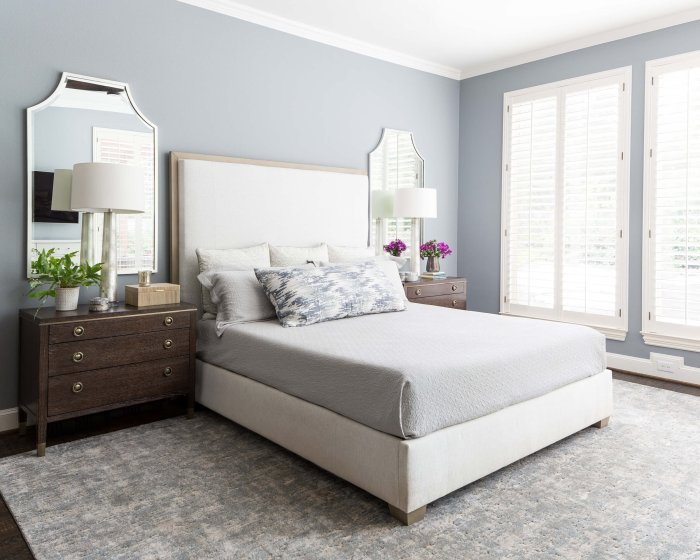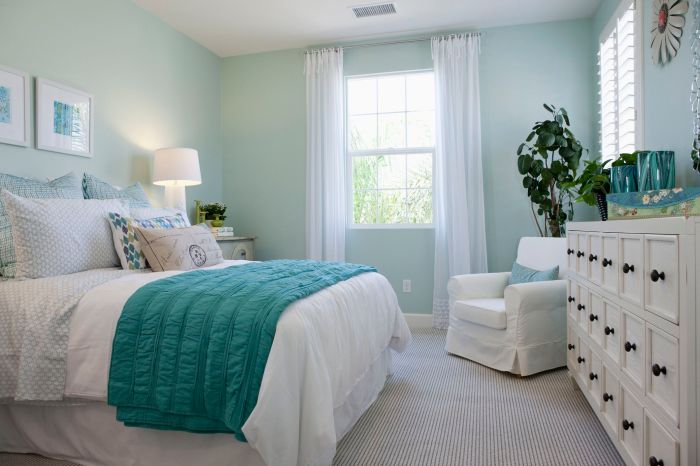
Impact of Different Paint Finishes: Interior Design Bedroom Paint Colors

Interior design bedroom paint colors – Choosing the right paint finish is crucial for achieving the desired aesthetic and functionality in a bedroom. The finish significantly impacts the room’s overall look and feel, influencing light reflection, durability, and ease of cleaning. Understanding the properties of different finishes allows for a more informed decision, ensuring the final result aligns with both personal preferences and practical needs.The selection of paint finish affects not only the visual appeal but also the longevity and practicality of the paint job.
Choosing the right interior design bedroom paint colors is crucial for creating a relaxing atmosphere. Light, neutral shades can make a small room feel more spacious, a key consideration when planning your master bedroom. For helpful tips on maximizing space, check out this guide on master bedroom design for small room before settling on your final paint color; the right color can complement your overall design perfectly.
Remember, the paint color sets the tone for the entire room’s ambiance.
Different finishes offer varying degrees of durability, washability, and light reflection, each impacting the overall atmosphere of the bedroom. Consideration of these factors is key to creating a space that is both beautiful and easy to maintain.
Paint Finish Properties and Suitability for Bedrooms
Matte, eggshell, satin, and gloss finishes each possess unique characteristics. Matte finishes, with their low sheen, offer a sophisticated, subtly textured look, ideal for hiding imperfections in the walls. However, their low washability makes them less suitable for high-traffic areas or rooms prone to stains. Eggshell finishes provide a slightly higher sheen than matte, offering improved washability while still maintaining a soft, elegant appearance.
Satin finishes offer a smooth, slightly glossy surface that is more durable and washable than matte or eggshell, making them a popular choice for bedrooms. Gloss finishes, with their high sheen, are the most durable and washable but can highlight wall imperfections and may feel too formal for some bedroom styles.
Pros and Cons of Different Paint Finishes
A comparison of the pros and cons helps clarify the best choice for a specific bedroom. For instance, the low sheen of a matte finish minimizes light reflection, creating a calm and relaxing atmosphere, perfect for a restful sleep environment. Conversely, the high sheen of a gloss finish maximizes light reflection, brightening the room but potentially making it feel less intimate.
Cleanability is another key factor; gloss and satin finishes are significantly easier to clean than matte or eggshell, a considerable advantage in a bedroom. Durability also varies; gloss is the most durable, followed by satin, eggshell, and then matte.
Impact of Paint Finishes on Bedroom Aesthetics
The chosen paint finish directly influences the overall aesthetic of the bedroom. A matte finish creates a more subdued and sophisticated look, ideal for minimalist or traditional styles. Eggshell offers a balance between a soft look and improved washability, suitable for various styles. Satin’s subtle sheen adds a touch of elegance and is versatile enough for contemporary or transitional styles.
Gloss finishes, while durable, might be considered too formal for some bedroom designs, better suited to spaces with a more modern or glamorous aesthetic. Consider the existing furniture and décor when selecting a finish to ensure harmony and consistency.
Comparison Table of Paint Finishes, Interior design bedroom paint colors
| Paint Finish | Light Reflection | Washability | Suitability for Bedroom Styles |
|---|---|---|---|
| Matte | Low | Low | Minimalist, Traditional, Rustic |
| Eggshell | Low to Medium | Medium | Traditional, Transitional, Contemporary |
| Satin | Medium | High | Contemporary, Transitional, Modern |
| Gloss | High | Very High | Modern, Glamorous |
Accent Walls and Color Blocking Techniques

Accent walls and color blocking are powerful tools in interior design, capable of transforming a bedroom from mundane to magnificent. These techniques allow for the strategic use of color to create visual interest, define spaces, and enhance the overall mood and atmosphere of the room. By carefully selecting colors and their placement, you can achieve a personalized and aesthetically pleasing bedroom design.
Effective accent wall techniques involve more than just choosing a bold color; it’s about understanding how color impacts the perception of space and how it interacts with the existing décor. Color blocking, a more advanced technique, involves using distinct blocks of color to create separate zones within a single room, adding a layer of complexity and sophistication.
Effective Accent Wall Techniques in Bedrooms
An accent wall can dramatically alter a bedroom’s feel. Consider a calming, spa-like atmosphere with a muted teal accent wall behind the headboard, complemented by soft white walls and neutral furnishings. Alternatively, a vibrant coral accent wall can inject energy and warmth, particularly effective in a north-facing room lacking natural light. The placement of the accent wall is crucial; behind the bed is a classic choice, drawing the eye to the focal point of the room.
A smaller accent wall, perhaps in a reading nook, can create a visually distinct and cozy area. Using a textured wallpaper instead of paint on the accent wall can add another layer of visual interest and texture to the space.
Color Blocking to Create Visual Interest and Define Areas
Color blocking goes beyond a single accent wall, dividing the bedroom into distinct zones using contrasting or complementary colors. For instance, a restful sleeping area could be painted a soft grey, while a playful workspace area adjacent to it could be painted a sunny yellow. This technique not only defines different functions within the room but also adds a dynamic and modern aesthetic.
The key is to choose colors that work well together, considering both their hues and saturation levels to avoid a clashing or jarring effect. The use of trim and molding can help to visually separate the color blocks, creating clean lines and a polished look.
Sample Bedroom Layout Showcasing Accent Wall and Color Blocking Techniques
Imagine a bedroom with a deep navy blue accent wall behind the bed. This creates a sophisticated and restful backdrop for sleeping. The remaining walls are painted a soft, warm white, maximizing the feeling of spaciousness and light. A section of the wall near a built-in desk is painted a cheerful, bright yellow, creating a visually distinct workspace. The navy blue grounds the room, offering a sense of calm and stability.
The warm white brightens and expands the space, while the yellow adds a pop of energy and creativity, perfect for a workspace. The contrast between the navy and yellow is visually striking but balanced by the neutral white, creating a harmonious and functional space. The navy provides a sophisticated and calming atmosphere for sleep, the white enhances spaciousness and brightness, and the yellow energizes the workspace area.
This careful selection and placement of colors create a cohesive yet dynamic bedroom design.
Tips on Choosing Complementary or Contrasting Colors
Selecting the right color palette is essential for a successful accent wall and color-blocking scheme. The following guidelines can help ensure harmony and visual appeal:
- Consider the existing décor: Choose colors that complement your furniture, bedding, and other accessories. A warm wood floor might pair well with earthy tones, while sleek modern furniture might look best with cool, neutral colors.
- Use the color wheel: The color wheel is a valuable tool for identifying complementary (opposite colors) and analogous (colors next to each other) color schemes. Complementary colors create high contrast, while analogous colors offer a more harmonious and subtle look.
- Think about the room’s size and lighting: Darker colors can make a room feel smaller, while lighter colors can make it feel larger. Consider the natural light in the room when selecting colors; a north-facing room might benefit from warmer tones, while a south-facing room might look better with cooler tones.
- Test your colors: Before committing to a full paint job, paint large swatches of your chosen colors on the walls to see how they look in different lighting conditions. This will help you avoid any unpleasant surprises.
FAQ Overview
What is the best paint sheen for a bedroom?
Eggshell or satin sheens are popular choices for bedrooms. They offer a good balance of durability, washability, and a subtle sheen that isn’t overly glossy.
How do I choose paint colors for a north-facing bedroom?
North-facing bedrooms tend to receive less natural light, so warmer colors like creams, yellows, or soft oranges can help brighten the space. Avoid very dark or cool colors which can make the room feel colder.
Can I use dark paint colors in a small bedroom?
Dark colors can work in small bedrooms if used strategically. Consider using them on an accent wall only, or opt for a dark, saturated shade with a high-gloss finish to reflect light.
How often should I repaint my bedroom?
The frequency depends on factors like wear and tear, but every 3-5 years is a common timeframe for repainting a bedroom, ensuring the walls remain fresh and vibrant.